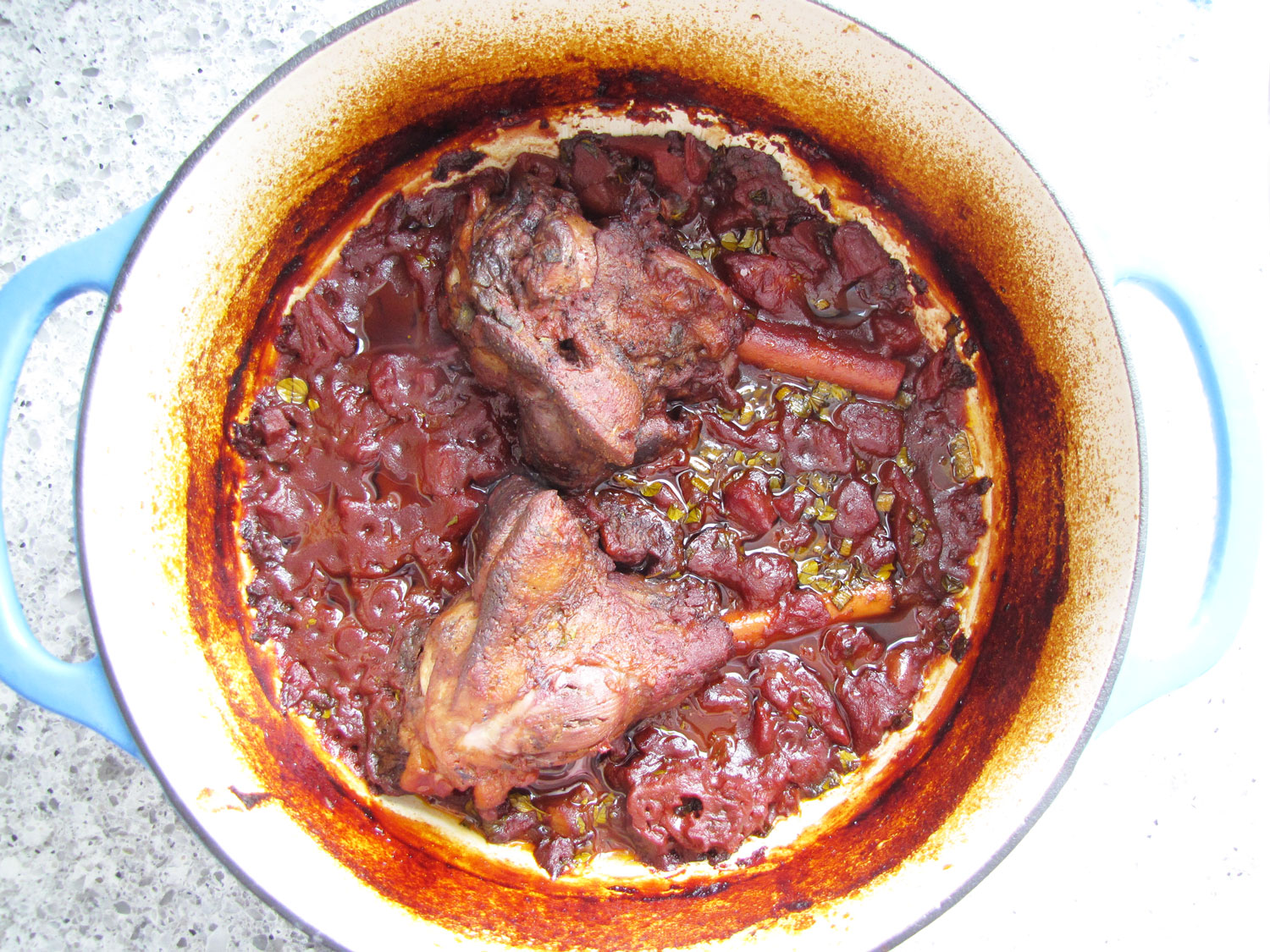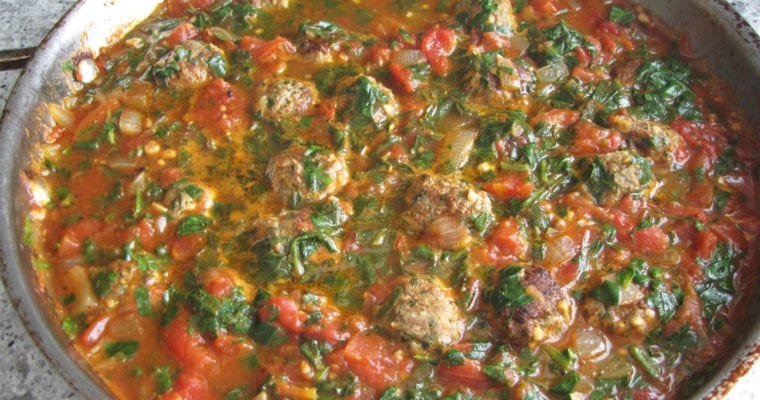TL/DR – Oven Braised Lamb Shanks in Tomato Sauce. The only difficult thing about this recipe is the patience required to reduce red wine and then slow braise lamb shanks for 2 1/2 hours. The lamb falls off the bone and the sauce is rich and tomatoey. –
A snowy weekend day is a PERFECT time to slowly braise meat. And why not lamb? Honestly, lamb is delicious. If you’ve only dabbled in ground lamb, try lamb shanks. Totally different story. They are still quite fatty, but you can mitigate that by trimming the fat initially and then allowing the sauce to sit post-braise and spoon off a generous amount of it.
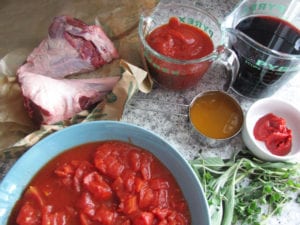

Start by trimming the fat from two lamb shanks and seasoning them with about 1 t kosher salt and 1/2 t pepper. Allow them to sit at room temperature for about 15 minutes. Then sear them on three sides in a very hot dutch oven for 2 minutes each side. Turn the heat down about halfway through the searing process. Remove the shanks.

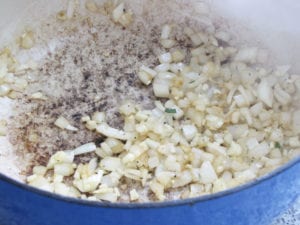
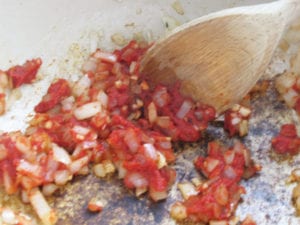
Drain the majority of the fat and add lots of onions and garlic. Allow these to cook for a few minutes, then add tomato paste and cook a couple of minutes more. Then add 2 cups of a decent Bordeaux wine and bring to a boil, then lower to medium. Reduce this by half, about ten minutes.
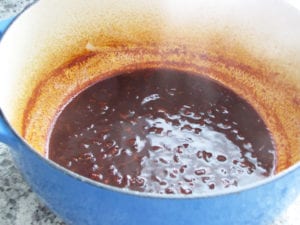

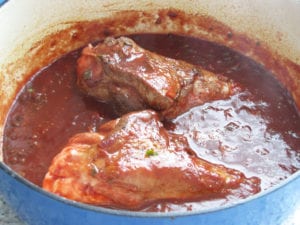
Add in chopped stewed tomatoes, (yes, you can used canned diced tomatoes, but stewed tomatoes are that much more yummy,) tomato puree, tons of fresh sage and fresh oregano, a bit of beef broth and a bit of kosher salt and some pepper. Bring this to a boil, stir, and then add in the lamb shanks, turning them to coat them well. Cover the dutch oven and place into a 325 degree oven. Braise for about 2 1/2 hours.
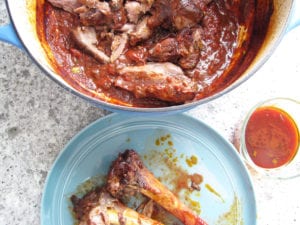
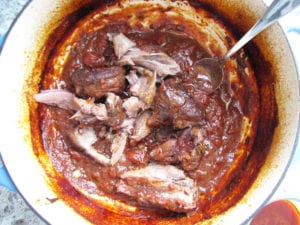
Remove the lamb from the dutch oven and then allow the sauce to sit for a few minutes. Spoon off the fat from the sauce. Then remove the chunks of tender lamb from the bone and place them back into the sauce and stir to coat them. Serve over polenta, pasta or rice. Polenta with butter, salt and parmesan cheese is pictured here.
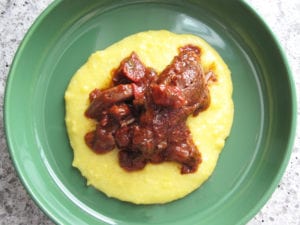
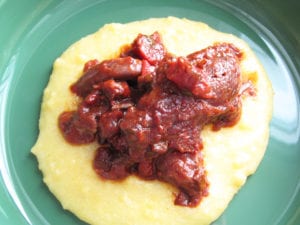
For another delicious slow-braised meat recipe, try Oven Braised Pulled Pork.
Oven Braised Lamb Shanks in Tomato Sauce
Slow braised lamb in a dutch oven with a rich tomato sauce whose base is a reduction of Bordeaux wine.
Ingredients
- 2 lamb shanks, trimmed of fat
- 1 1/2 t kosher salt, divided
- 1 T canola oil or other high smoke point oil
- 1/2 t freshly ground pepper, divided
- 4 cloves garlic, minced
- 1 small yellow onion, diced
- 2 T tomato paste
- 2 c red wine, preferably Bordeaux
- 1/2 c low sodium beef broth
- 1 14.5 oz can stewed tomatoes, removed from can and chopped
- 1 c tomato puree
- 1/4 c fresh oregano, minced
- 1/4 c fresh sage, minced
Directions
- Step 1 Preheat the oven to 325 degrees F.
- Step 2 Season the lamb shanks with 1 t kosher salt and 1/4 t freshly ground pepper. Allow to sit for 15 minutes at room temperature.
- Step 3 In a heavy dutch oven on high heat, sear the lamb shanks for two minutes at a time on three sides. Lower the heat if necessary to prevent burning. Remove and rest them on a plate.
- Step 4 Drain the majority of the fat from the dutch oven, then at medium – low heat, sauté the onions and garlic for 4 minutes, taking care not to burn them.
- Step 5 Add the tomato paste and cook for two minutes more, stirring.
- Step 6 Slowly add the wine and gently scrape up the brown bits from the bottom of the pot as you stir.
- Step 7 Turn the heat to medium – high and reduce the wine by half, about ten minutes.
- Step 8 To the reduced wine mixture, add the broth, stewed tomatoes, tomato puree, herbs, and the remaining 1/2 t salt and 1/4 t freshly ground pepper. Stir well.
- Step 9 Add the lamb shanks back to the dutch oven and stir to coat them. Bring the sauce back to a simmer. Cover and put into the preheated oven and braise for 2 – 2 1/2 hours.
- Step 10 Once the meat is falling-off-the-bone tender, remove the pot from the oven and remove the shanks to a plate.
- Step 11 As the sauce sits for about 5 to 10 minutes, it will be easy to spoon off the majority of the excess fat into a dish and discard in the trash.
- Step 12 Once the sauce has been defatted, remove the meat in chunks from the bones and add it back into the sauce. Taste and season if necessary. Serve over parmesan polenta (pictured,) pasta or rice.

